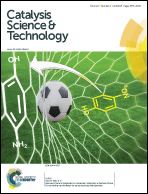Mechanistic insights into hydrogen generation for catalytic hydrolysis and alcoholysis of silanes with high-valent oxorhenium(v) complexes†
Abstract
The high-valent oxorhenium(V) complex [Re(O)(hoz)2]+ (1)-catalyzed hydrolytic oxidation of silanes to produce dihydrogen was studied computationally to determine the underlying mechanism. Our results suggested that the oxorhenium(V) complex 1-catalyzed hydrolysis/alcoholysis of silanes proceeds via the ionic out-sphere mechanistic pathway. The turnover-limiting step was found to be the heterolytic cleavage of the Si–H bond and featured a SN2–Si transition state, which corresponds to the nucleophilic anti attack of water or alcohol on the silicon atom in a cis η1-silane rhenium(V) adduct. Dihydrogen was generated upon transferring the hydride from the neutral rhenium hydride [Re(O)(hoz)2H] to the solvated [Me3SiOHR]+ ion. The activation free energy of the turnover-limiting step along the ionic outer-sphere pathway was calculated to be 15.7 kcal mol−1 with water, 15.4 kcal mol−1 with methanol, and 15.9 kcal mol−1 with ethanol. These values are energetically more favorable than the [2 + 2] addition pathway by ~15.0 kcal mol−1. Furthermore, the previously proposed catalytic pathways involving transient rhenium(VII) complexes or via the silicon attack on a rhenium hydroxo/alkoxo complex are shown to possess higher barriers.


 Please wait while we load your content...
Please wait while we load your content...